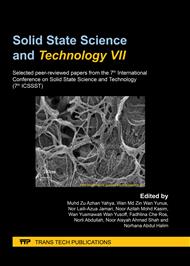p.3
p.10
p.17
p.22
p.28
p.35
p.46
p.53
p.60
Band Structure and Thermoelectric Properties of Ni(x)Zn(1-x)Fe2O4
Abstract:
Thermoelectric materials has made a great potential in sustainable energy industries, which enable the energy conversion from heat to electricity. The band structure and thermoelectric properties of Ni(x)Zn(1-x)Fe2O4 have been investigated. The bulk pellets were prepared from analytical grade ZnO, NiO and Fe2O3 powder using solid-state method. It was possible to obtain high thermoelectric properties of Ni(x)Zn(1-x)Fe2O4 by controlling the ratios of dopants and the sintering temperature. XRD analysis showed that the fabricated samples have a single phase formation of cubic spinel structure. The thermoelectric properties of Ni(x)Zn(1-x)Fe2O4 pellets improved with increasing Ni. The electrical conductivity of Ni(x)Zn(1-x)Fe2O4 pellets decreased with increasing Ni content. The electrical conductivity of Ni(x)Zn(1-x)Fe2O4 (x = 0.0) is (0.515 x10-3 Scm-1). The band structure shows that ZnxCu1-xFe2O4 is an indirect band gap material with the valence band maximum (VBM) at M and conduction band minimum (CBM) at A. The band gap of Ni(x)Zn(1-x)Fe2O4 increased with increasing Ni content. The increasing band gap correlated with the lower electrical conductivity. The thermal conductivity of Ni(x)Zn(1-x)Fe2O4 pellets decreased with increasing Ni content. The presence of Ni served to decrease thermal conductivity by 8 Wm-1K-1 over pure samples. The magnitude of the Seebeck coefficient for Ni(x)Zn(1-x)Fe2O4 pellets increased with increasing amounts of Ni. The figure of merit for Ni(x)Zn(1-x)Fe2O4 pellets and thin films was improved by increasing Ni due to its high Seebeck coefficient and low thermal conductivity.
Info:
Periodical:
Pages:
28-34
Citation:
Online since:
May 2021
Authors:
Price:
Сopyright:
© 2021 Trans Tech Publications Ltd. All Rights Reserved
Share:
Citation:


